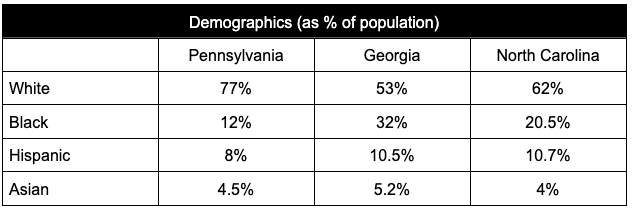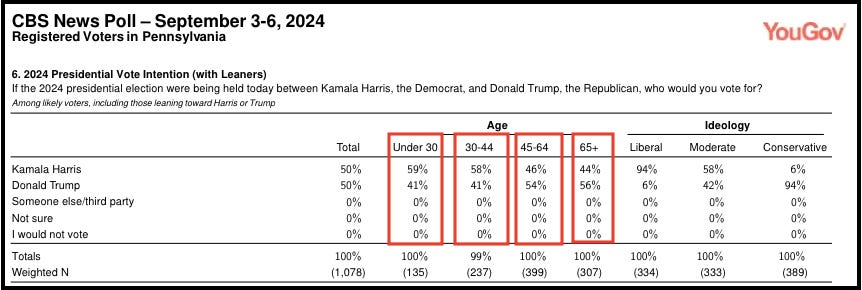Can Harris Win Without Pennsylvania?
The traditional path to 270 goes through Pennsylvania. But North Carolina and Georgia may be friendlier territory for Harris.
As I wrote yesterday, the race for president has entered the final 50 day stretch as a close race. For the next eight weeks both campaigns will be working to ensure they enter election day with the maximum number of credible pathways to 270 electoral votes. As of today, each campaign has multiple pathways made up of several combinations of different states. While the most direct route to 270 for both campaigns involves Pennsylvania, that may not be the most practical route for Kamala Harris. Let’s take a look.
For Harris, the most straightforward path is the “blue wall”-- Pennsylvania, Wisconsin and Michigan– three states that Trump won in 2016 and Biden flipped back in 2020. If Harris were to win the three “blue wall” states and lose the other four battleground states– North Carolina, Georgia, Nevada and Arizona– she would still squeak out a narrow victory with 271 electoral votes. However, were she to lose Pennsylvania, where her polling has been the softest of the “blue wall” states, she still has other pathways but they get trickier. Because all of the remaining four states (Nevada, North Carolina, Georgia or Arizona) have fewer electoral votes then Pennsylvania’s 19, Harris would need to win two of those remaining four. Her most likely path in this case would be to pick up one of the southern states– where her polling is competitive– along with Nevada. That would land her at 274 electoral votes.
For Trump it’s a similar story. He can win without Pennsylvania but a victory in the Keystone State would open up pathways to 270 that avoid traditionally Democratic states and allow him to close the deal with a state like Georgia or Arizona– historically friendlier turf for Republicans.
While winning Pennsylvania would be the fastest way to 270 for Harris this could be the election where the “blue wall” crumbles but the Democrat still wins. Based on where the race stands right now, a path to 270 that runs through the south- Georgia and/or North Carolina– may be more likely. Harris’s soft polling in Pennsylvania is highlighting what I have long felt: despite their histories as Republican states, Georgia and North Carolina are friendlier territory for her.
Both North Carolina and Georgia have seen major demographic shifts over the last couple of decades. Georgia, for example, had a population in 1990 that was 71% white. According to the 2020 census, the percentage of white residents now stands at 52%, while black, hispanic and asian communities make up about 46% of the population. Compare that to Pennsylvania where nearly 77% of the population is white and just 12% is black. In North Carolina it’s a similar story. The percentage of white residents has dropped from 77% in 1990 to 62% in 2020. Harris is currently lagging Trump with white voters but holds commanding leads with black, hispanic and asian voters, indicating that Georgia and North Carolina could be fertile ground for her.
But it’s not just race. Generally speaking, Democrats do better with young voters and Republicans do better with older voters, who tend to skew more conservative. That has held true for Harris who is performing well with voters under 45 but is losing to Trump among older voters. To illustrate this point here’s a snapshot of the crosstabs from a recent poll of Pennsylvania. In this particular poll Harris has a sizable lead among voters 18-29 and 30-44. But that support flips once you get to voters over the age of 45. This tells me Harris would likely benefit from an electorate that skews younger.
According to the 2020 census, just over 19% of Pennsylvania’s population is 65+, ranking 9th in terms of states with the highest population of seniors. Georgia, on the other hand, has one of the smallest populations of seniors, coming in at number 47 out of 50. North Carolina’s population is getting older but as of the last census they ranked in the bottom half of states (#28). Not to belabor the point but the median age in Pennsylvania is 41 versus 37 in Georgia and 39 in North Carolina. North Carolina also has a larger percentage of the population that holds a college degree, which is another group that Harris performs well with.
Finally, I can’t think of another swing state that’s witnessed more of Trump’s legal drama in the last four years then Georgia. That’s largely because of Trump’s role in trying to overturn the 2020 election results in Georgia, which lead to the charges he is currently facing in Fulton County. I strongly believe that Trump’s legal troubles won’t play a role in the final outcome of the election but I do wonder how four years of bad press and strained relationships with high profile, popular Republicans in the state will affect Trump’s support. Voters nationwide are reporting that they want to turn the page on chaos and drama and few states have been subjected to more Trump drama than Georgia.
So, where does that leave us? Who shows up to vote more than how many show up to vote is likely what’s going to decide this election. If the electorate in Pennsylvania is friendly to Democrats on election day she can absolutely win the state I wouldn’t count her out yet. But the younger, more diverse electorates in North Carolina and Georgia seem like friendlier turf for Harris at this point. But remember, North Carolina or Georgia alone are not one-for-one swaps with Pennsylvania in terms of electoral votes. She’ll still need one other state, like Nevada, to hit 270– though that’s moot if she wins both southern states.
The conventional wisdom has been that a Democrat can’t win without winning the “blue wall.” But at this point in the election I think it’s more likely than not that if Harris wins the election her road to 270 will go right through the heart of the south.




